The Scilands panel at SLCC presented three projects, “Second Health – Visiting A London Hospital of the Future” (picture above), “Demystifying Nuclear Power,” and NOAA‘s “Second Earth in Second Life.” These innovative projects put Second Life center stage in a vision to design better worlds for tomorrow (see also Maya Realities).
All the panel members are key players in the formation and development of SciLands – “an emerging Second Life continent dedicated to serious applications.” SciLands was only founded in January of this year. But the number of projects has escalated rapidly – now up to 34 islands and members from 3 continents.
From left to right: panel moderator James Dearnley, Loughborough University Dept. of Information Science; Dave Taylor, (SL: Davee Commerce) who leads the UK’s National Physical Laboratory‘s (NPL) Second Life activities including Second Health – The Future of Healthcare Communication, and Nanotechnology Island in Second Life; Jeffrey Corbin (SL: Zazen Manbi), research associate at the University of Denver, who is preparing to build a nuclear reactor in Second Life to train the next generation of environmental assessment specialists and to educate people about nuclear power (This project is a collaboration with Robert C. Amme, a research professor of physics at the University of Denver.); Eric Hackathorn (SL: Hackshaven Harford), NOAA, who has designed a public 3-D space to highlight the research NOAA performs, and recently formed a company Maya Realities to explore 3-D virtual world metrics, and Katherine Prawl (SL: Kat Lemieux), co-founder of The International Spaceflight Museum in Second Life.
Government Agencies are doing some very innovative work in Second Life.

This is Dave Taylor’s personal avatar, Davee Commerce. Another of his avatars, named “Innovation Projects” manages Nanotechnology Island, NPL’s pavilion at the International Spaceflight Museum and UK Future Focus, a cross-Government thinktank.
At SLCC, Dave Taylor, Knowledge Transfer Leader in the Quality of Life Division of the UK’s National Physical Laboratory unveiled publicly, for the first time, NPL’s healthcare of the future project for Imperial College London, Second Health.
NPL is a government laboratory and world leading research institute with specialists in a whole range of different skills. Part of their work is to manage knowledge transfer networks which enable scientists, technologists and policy makers to talk about issues of the day.
Dave explained that scientists and technologists are all used to talking to people in the same discipline. But, his interest in SciLands was the opportunity to get different science communities, who are normally in their silos, together “to get a conversation happening across the boundaries of different disciplines because that is where innovation really happens.” For example, “in one technical discipline people may very well have the solutions for problems for another technical discipline. But, they would never know about it because they never speak.”
Second Health
Second Health is a project created by NPL for Imperial College London (ICL) to communicate “complex healthcare messages and illustrate what healthcare of the future could look like.” Dave Taylor introduced Second Health by explaining that most of today’s most pressing social concerns, like healthcare, have underlying technical considerations. And, that the mass media does not always lend itself to the nuances of technical issues. Through a series of recent newspaper headlines he demonstrated how traditional media is unable to communicate the complex issues facing healthcare today.
At the heart of the Second Health project is not only a virtual hospital in Second Life but also a series of machinima (videos made using Second Life) that tell the story of future healthcare to help people understand different pathways of care, and to “develop a better understanding of how they may experience healthcare.”
In the picture above I am watching one of these films in Second Life. These machinima make the virtual health campus accessible to people “wherever they are, and whatever their comfort with digital technology.”
The virtual hospital in Second Life and Second Life avatars were used as the sets and characters in conjunction with real life settings and people to create these films. They are very high quality productions by film maker Dylan Byrne. They are distributed on a range of websites including YouTube, and, in Second Life.
Click on the image to play the video, “Second Health: Emergency and Specialist Care.”
Dave chose a conventional film maker rather than an experienced machinimatographer as he intended to break new ground with these movies. “I also discovered how difficult it is to create normal-looking people in Second Life. Almost all of the store bought avatars and clothes are too exotic to represent patients and staff in the NHS.” When people not used to Second Life see these movies they understand them immediately through the story-telling. “That is exactly what we had to achieve”, says Dave. “They treat them like conventional computer animations they see all the time.”
But, unlike regular computer animation, the virtual hospital in Second Life lives on and is open for people to visit. It is in the SciLands and has it’s own orientation experience. The virtual hospital campus in Second Life provides an immersive 3D learning experience that allows people to explore health care of the future in a collaborative environment where they can meet and talk to other people and share their experiences on the spot. The movies start automatically whenever an avatar comes close, so that people new to Second Life don’t have to search around for where to click to play.
The future hospital in Second Life does not represent any single hospital or plan but is a vision of what hospitals could be like. It is built to Imperial College’s specification based on recommendations in the UK National Health Care Service London Framework for Action report which details how Professor Sir Ara Darzi believes London’s healthcare needs to change over the next ten years. Professor Ara Darzi, who is now Parliamentary Under Secretary for Health in the UK and a member of the House of Lords is now leading the reform of the National Health Service.
However, ICL and NPL are testing the effectiveness of Second Life as a medium for conveying complex healthcare delivery messages and essential healthcare information to care givers, doctors and the public. “In the future we expect to provide healthcare services in the metaverse.”
Dave Taylor said:
Our challenge was to help people understand what it might be like to visit a London health campus in the near future, before building work has even begun. By inviting them into a virtual hospital, we can communicate directly with future patients. We are not testing the London review’s specific recommendations, although the hospital is built on the principles that Sir Ara Darzi developed – that will be done at the local level through public consultations.
What we are interested in doing is understanding and measuring exactly how well this kind of technology communicates these technical ideas to the public and whether it can be used for public consultation, or even for the delivery of health services in the future.
This is Minna Runo the avatar of Ani Simon-Hart a Knowledge Transfer Delivery Specialist at NPL working with Dave. I met her on Second Health when I dropped in to take some photos.
Interview With Dave Taylor at SLCC
At breakfast, Sunday morning at SLCC, I had the opportunity to ask Dave some questions. We began with how he got into Second Life.
I got into Second Life when I realized what a powerful collaboration and social networking environment it was. And, in general what a great way it was to disseminate information to people who don’t know to come to your web site and look for it there.
In 2005, I discovered there was a group planning an International Space Flight Museum – a virtual museum that couldn’t exist in the real world and I thought wow! NPL does a lot of development, testing and knowledge transfer work for the real world space industries. There must also be people who are interested in space in Second Life. So I knew who I wanted to talk to when I first logged in. And, because I found them within half an hour, I thought this is the best networking environment ever! And, it has proved to be the case because a lot of people I am working with today I would never have met in the real world, wouldn’t have mixed with them. And, there are many new projects that are coming out of that meeting. The SciLands is one such project.
NPL was the first real world organization to rent space on the International Space Flight Museum. And we were there the day they launched. So I have watched the growth of interest in the space industry right from the start.
And, I discovered, and this is what went on with the Web too in 1994, you couldn’t really understand what is going on unless you are there. And just being there as an observer isn’t enough to understand what all the affordances of a new media are. I knew that from the Web. And, it is certainly true of Second Life. Now knowing what is going on means you have got to be a participant, you have to be practically doing stuff.
Dave’s first effort on Second Life was an exhibition for TRUTHS, NPL’s proposed low cost Earth Observation satellite – and calibration laboratory in space that can help gather fundamental climate change data 10 times as accurately as any other instrument.
And, I discovered from people that blogged about it that people had actually understood the science I had been explaining. And, it was about a very important issue which I feel very strongly about and a lot of people at NPL feel very strongly about and are doing a lot of work on – that is improving the data behind climate models, and therefore be able to make much more accurate and certain predictions about what is going to happen to the climate under a number of different scenarios.
Dave pointed out how his early experiments in Second Life quickly showed him what a great environment Second Life is for getting across the complex technical issues across to people who care about the social issues behind science. He uses Second Life metric analysis tools of Maya Realites to show the “stickiness” of various aspects of these Second Life projects. Dave is one of the founders of SciLands – and this provides serious users a supportive environment with orientation help, a networking environment with like minded people, weekly meetings, and shared resources such as lecture theatres and an auditorium that can seat 200 avatars.
Dave has some very interesting projects in the pipeline including a new TRUTHS exhibit and Nanotechnology Island in Second Life.
Philip Rosedale Invited To Speak at Framework 7 Conference on Privacy Enhancing Technologies.
NPL and the Location and Timing Knowledge Transfer Network have invited Philip Rosedale, founder of Linden Lab, to be one of the keynote speakers at the ‘Fine Balance 2007′ event in November. This event’s workshop on Web 2.0 aims to help identify and prioritize strategic research directions and provide input to the European Commission on privacy enhancing technologies for virtual worlds and Web 2.0.
The output from this workshop will be taken into consideration for a future Framework 7 research call, funded by the EU in these areas. Some of the technologies the European Commission will likely support are privacy enhancing technologies for the internet, health records, biometrics, identity cards, social web, virtual worlds and more.
EC supported workshop to be held in Whitehall, London and in Second Life.
This is the first time that a European Commission supported event has been held in Second Life. It will be a one day conference held in Whitehall, London with about 150 people attending. The keynote speakers and afternoon workshop on Web 2.0 and virtual worlds will be streamed into Second Life for participants and speakers who cannot be there in person.
Second Earth and “Science on a Sphere”
After SLCC, even though I returned home to New York City with a massive content overload, I couldn’t resist dropping into Meteora to talk to Haskshaven Harford the avatar of Eric Hackathorn from NOAA. Eric has designed a public 3-D space to highlight the research NOAA performs, and is COO of Maya Realities a company formed to explore 3-D virtual world metrics.
NOAA – part of the US Government specifically for climate change that looks at global warming and includes the National Weather Service. At SLCC, Eric introduced NOAA’s exciting new project on Second Life called Second Earth. Eric gave credit to this Technology Review article for the name.
Second Earth is a project that NOAA has just acquired 9 sims to start. They aim to stream live data onto a replica of the earth in Second Life, to bring geospatial, weather and many other kinds of data into the collaborative environment of Second Life to create a social decision making tool.
Dave Taylor is keen that the International community also participates and is working hard to get European funding for a collaboration with NOAA. According to Dave “Scientists need data for their research, and lots of data are locked up in individual projects. This project and others being considered by climate researchers will enable the sharing of data by scientists, researchers and policymakers.” Dave explained that NPL chairs a global community that is studying the problem of comparability and validation of Earth Observation data, just the kind that this project supports. “Visual data is so much more compelling and understandable to the non-specialist and scientists in other fields”.
The project brings together two projects that NOAA has already implemented in Second Life – Science on a Sphere that at the moment is limited to streaming video onto a globe (see the picture above), and the weather map project (picture below) that streams live weather data from the NOAA web site onto a map in Second Life.
Hackshaven explained: “There are already installations of Science on a Sphere in several locations now all over the world. This is the virtual version and the basis for the new second earth project.”
Science On a Sphere is a room sized, global display system that uses computers and video projectors to display planetary data onto a six foot diameter sphere, analogous to a giant animated globe.
“Second Earth is just getting started,” Hackshaven explained. “Eventually it will be a globe like this one only much larger 9 sims worth. And, it will be a combination of science on a sphere and the weather map, google earth + second life.”
“Nuclear Power Stations in Second Life”
Jeffrey Corbin, whose avatar Zazen Manbi is pictured above, recently obtained funding for teaching an environmental impact course in Second Life. He and Dave Taylor intend to build a functional but virtual Nuclear Power Station, as a shared facility between the US and Europe to help explain and demystify nuclear power and its vital role in controlling global warming.

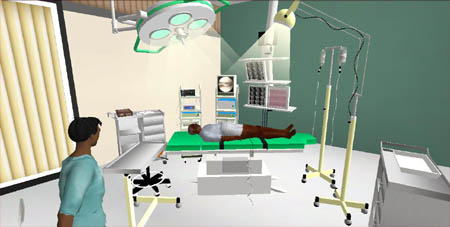
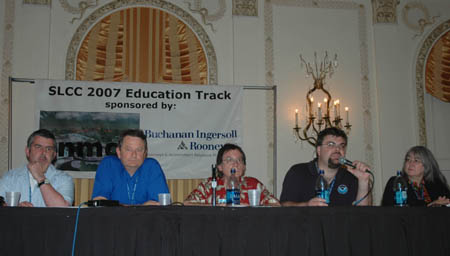
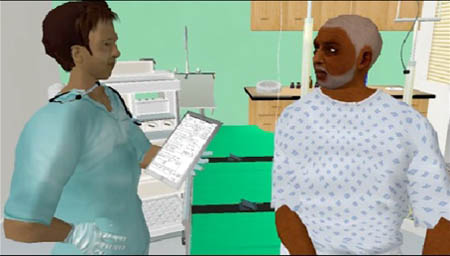

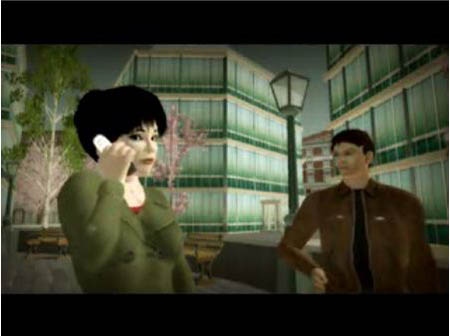
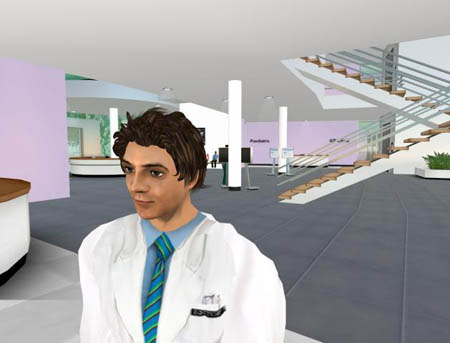

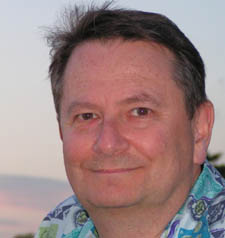


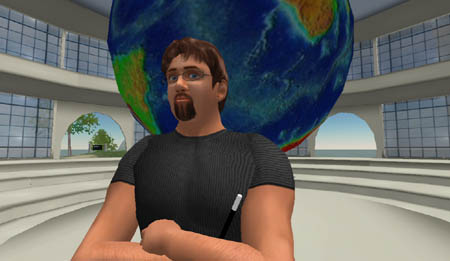
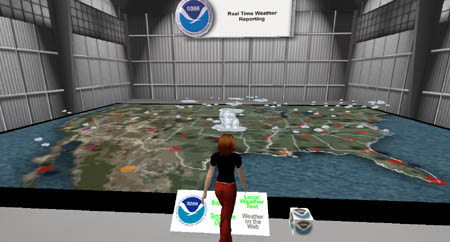
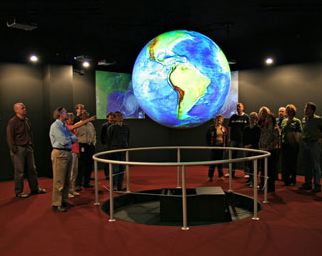

August 30th, 2007 at 3:15 pm
I hope they capture the real (virtual) reality of working in nuclear power plants, and not the perception of it as expressed by those on the outside, whether pro- or anti- nuclear. It’s much different if you’re on the inside. For a painless look from the US perspective, see my novel “Rad Decision”, free online at http://RadDecision.blogspot.com or in paperback.
September 6th, 2007 at 9:32 pm
Excellent post! I’ve added a link to this from the SciLands blog after seeing James Dearnley’s reference to it on Facebook. Thank you for such a well-written and detailed article.
February 1st, 2008 at 1:07 pm
Many thanks for all of your hard work on this great blog. I wanted to draw your attention to a surgical meeting we are trying to host in Second Life in April. We have created the International Virtual Association of Surgeons (iVAS) and we now have an active group in Second Life. The aim is to use virtual worlds as a novel method for collaboration and dissemination of surgical research.
This is being run as part of Imperial College’s Second Health project (www.secondhealth.org.uk). The address for the conference is:
http://ubimon.doc.ic.ac.uk/iVAS/m660.html
The deadline for submissions is the 8th of Feburary 2008 and the conference will be held on April 22nd 2008.
We are keen for anyone interested to submit their work so that we can try and prove the concept that virtual worlds are a valid method of scientific communication, and we would be most grateful for your help in doing this.
Thanks again, and please don’t hesitate to contact me should you have any further questions.
Kind regards,
James Kinross